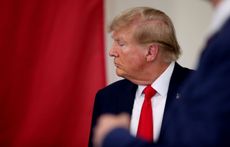How the Tea Party became an anti-war movement
Liberals aren't the only ones — or even necessarily the loudest — arguing against attacking Syria


The Tea Party movement formed in early 2009 to protest an Obama administration housing and bank bailout proposal, gathered strength opposing ObamaCare and taxes, and evolved into a reliably Republican voting and advocacy force. There has always been some tension between the Tea Party and GOP leadership — especially in Speaker John Boehner's (R-Ohio) House. But it's always been the Tea Party trying to pull the GOP to the right.
Now, the Tea Party is linking arms with bearded leftist peaceniks — literally — at rallies opposing U.S. intervention in Syria, says Trip Gabriel in The New York Times. The first time Clark County (Indiana) Tea Party Patriots leader Kelly Khuri found herself protesting alongside progressive anti-war activists, she tells The Times, "it kind of freaked me out."
But Khuri's Tea Party group appears to be the rule rather than the exception on Syria. "I haven't seen grass-roots response this huge since that first opposition to TARP," says Matt Kibbe, the president of FreedomWorks, which recently urged lawmakers to oppose intervention in Syria. How did we get here?
Subscribe to The Week
Escape your echo chamber. Get the facts behind the news, plus analysis from multiple perspectives.

Sign up for The Week's Free Newsletters
From our morning news briefing to a weekly Good News Newsletter, get the best of The Week delivered directly to your inbox.
From our morning news briefing to a weekly Good News Newsletter, get the best of The Week delivered directly to your inbox.
In Congress, the libertarian faction of the GOP has been gaining ground since George W. Bush left office and former Rep. Ron Paul (R-Texas) became a prominent voice, now represented most vocally by Paul's son, Sen. Rand Paul (R-Ky.). Along with opposing taxes, regulation, and government generally, the libertarian Republicans tend to be wary about intervening abroad.
The first sign that a real alliance of "progressive anti-war Democrats and isolationist Tea Party libertarians" was actually materializing, says Greg Sargent at The Washington Post, was the narrow defeat of a proposal by conservative Rep. Justin Amash (R-Mich.) and liberal stalwart Rep. John Conyers (D-Mich.) to restrict NSA domestic phone surveillance.
We're already seeing substantial numbers of members who voted to end NSA surveillance now coming out or leaning against action in Syria.... In both cases — on Syria, and on the amendment to end NSA surveillance — this loose alliance of lawmakers is allied against the leadership of their own parties. And in both cases, they represent a genuine threat to the outcome. [Washington Post]
The conservative anti-war wing in Congress still pales in comparison to the stay-out-of Syria fervor among rank-and-file Tea Partiers. It's not all bottom-up: Tea Party–aligned commentators like Glenn Beck are just as vocally against intervening in Syria as liberals like Dennis Kucinich and Rep. Alan Grayson (D-Fla.). But in a movement that's proudly free of any central spokespeople, there's more going on than marching orders from Beck.
A big part of it is money: Wars are expensive, even if they're tiny ones waged by very costly Tomahawk missiles, and the Tea Party wing of the GOP views the Pentagon's massive budget as less sacrosanct than traditional or mainstream Republicans.
Sign up for Today's Best Articles in your inbox
A free daily email with the biggest news stories of the day – and the best features from TheWeek.com
More skeptical observers "see simple obstructionism, not philosophical fundamentals, in the emerging anti-war wing of the right," says Patrik Jonsson at The Christian Science Monitor. In this view, "the anti-war push is simply part of a philosophy that sees any federal government action as illegitimate." It's an open question, though, whether this antiwar enthusiasm is even "a genuine philosophical viewpoint or simply more political obstructionism of Mr. Obama's agenda," Jonsson says.
"If this were a Republican president making the exact same case, more Republicans would be supportive," says the Cato Institute's Justin Logan.
Whatever the reason, the GOP/Tea Party "isolationist strain is proving increasingly popular," say McClatchy's David Lightman and Maria Recio. "The Senate's potential 2016 Republican presidential candidates all are pushing non-intervention and finding appreciative audiences."
It's an open question "whether the Tea Party becomes a long-term anti-war force, outlasting the Syria issue — which contains an element of bald anti-Obama sentiment," says The New York Times' Gabriel. Kibbe, the FeedomWorks president, says the Ron Paul wing of the party really is gaining ground over the neo-conservatives and hawks who have held sway since the Eisenhower administration.
"There's a recentering or realignment going on in the Republican Party," Kibbe tells The New York Times. And at least for now, the Tea Party has a new driving purpose.
Create an account with the same email registered to your subscription to unlock access.
Peter has worked as a news and culture writer and editor at The Week since the site's launch in 2008. He covers politics, world affairs, religion and cultural currents. His journalism career began as a copy editor at a financial newswire and has included editorial positions at The New York Times Magazine, Facts on File, and Oregon State University.
-
 'Elevating Earth Day into a national holiday is not radical — it's practical'
'Elevating Earth Day into a national holiday is not radical — it's practical'Instant Opinion Opinion, comment and editorials of the day
By Harold Maass, The Week US Published
-
 UAW scores historic win in South at VW plant
UAW scores historic win in South at VW plantSpeed Read Volkswagen workers in Tennessee have voted to join the United Auto Workers union
By Peter Weber, The Week US Published
-
 Today's political cartoons - April 22, 2024
Today's political cartoons - April 22, 2024Cartoons Monday's cartoons - dystopian laughs, WNBA salaries, and more
By The Week US Published
-
 Arizona court reinstates 1864 abortion ban
Arizona court reinstates 1864 abortion banSpeed Read The law makes all abortions illegal in the state except to save the mother's life
By Rafi Schwartz, The Week US Published
-
 Trump, billions richer, is selling Bibles
Trump, billions richer, is selling BiblesSpeed Read The former president is hawking a $60 "God Bless the USA Bible"
By Peter Weber, The Week US Published
-
 The debate about Biden's age and mental fitness
The debate about Biden's age and mental fitnessIn Depth Some critics argue Biden is too old to run again. Does the argument have merit?
By Grayson Quay Published
-
 How would a second Trump presidency affect Britain?
How would a second Trump presidency affect Britain?Today's Big Question Re-election of Republican frontrunner could threaten UK security, warns former head of secret service
By Harriet Marsden, The Week UK Published
-
 'Rwanda plan is less a deterrent and more a bluff'
'Rwanda plan is less a deterrent and more a bluff'Instant Opinion Opinion, comment and editorials of the day
By The Week UK Published
-
 Henry Kissinger dies aged 100: a complicated legacy?
Henry Kissinger dies aged 100: a complicated legacy?Talking Point Top US diplomat and Nobel Peace Prize winner remembered as both foreign policy genius and war criminal
By Harriet Marsden, The Week UK Last updated
-
 Trump’s rhetoric: a shift to 'straight-up Nazi talk'
Trump’s rhetoric: a shift to 'straight-up Nazi talk'Why everyone's talking about Would-be president's sinister language is backed by an incendiary policy agenda, say commentators
By The Week UK Published
-
 More covfefe: is the world ready for a second Donald Trump presidency?
More covfefe: is the world ready for a second Donald Trump presidency?Today's Big Question Republican's re-election would be a 'nightmare' scenario for Europe, Ukraine and the West
By Sorcha Bradley, The Week UK Published